Exploring Greenery in Dubai: Urban Flora and Impact
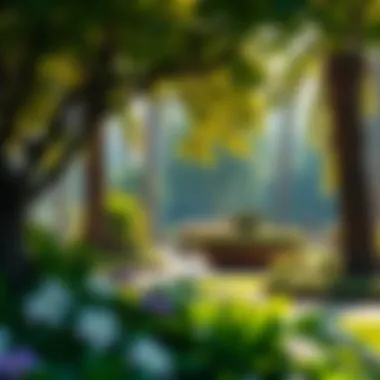
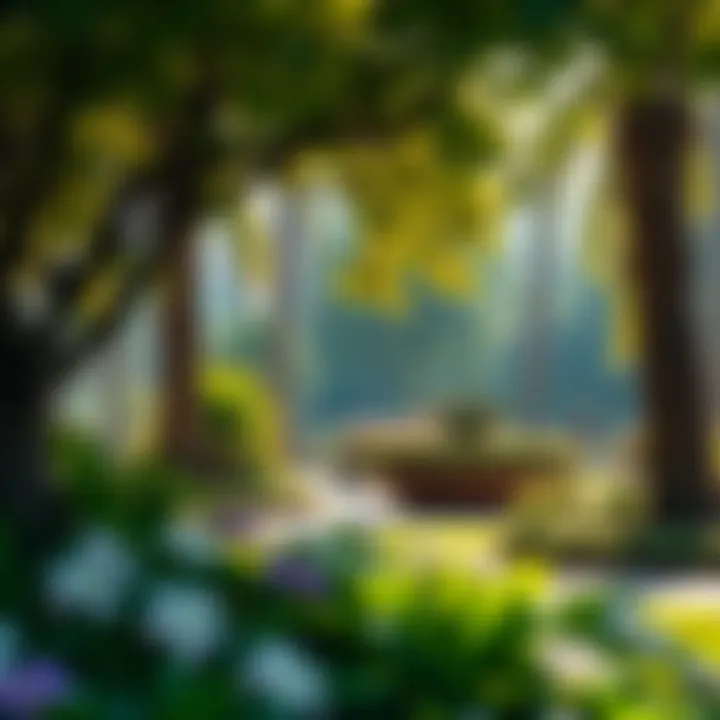
Intro
Dubai, a city often associated with towering skyscrapers and an arid desert, is gradually reshaping its narrative. Greenery is not simply an ornament in this urban oasis; rather, it plays a vital role in crafting a more sustainable living space. The progression of green spaces in Dubai reflects a harmonious blend of innovative architecture and nature. This article will dissect various dimensions of greenery in the region, from its historical context to its role in contemporary urban planning.
As we journey through this analysis, we’ll also be looking at how these pockets of green influence real estate dynamics, acting as a critical factor for buyers and investors alike. Urban planners today recognize that integrating nature into the urban fabric doesn't just enhance aesthetic appeal; it can significantly elevate the quality of life for residents. Furthermore, the presence of green spaces may just sway the scales of real estate value in this burgeoning market.
In an era where sustainability is more than a buzzword, Dubai is making strides in transforming its approach to urban living. This narrative is targeted to enlighten investors, agents, and expatriates on the implications and techniques for effective investment in this lushening landscape. Buckle up as we explore the vibrant greenery in Dubai, the forces driving its growth, and the myriad opportunities that lie therein.
The Importance of Greenery in Dubai
In a city that seems to thrive on its lavish skyscrapers and vast deserts, greenery holds a paramount significance that is often overlooked. As Dubai continues to grow at an unprecedented pace, the role of green spaces transitions from mere aesthetic appeal to a fundamental element that enhances the quality of urban living. The importance of greenery in Dubai encompasses a wide array of benefits that can positively influence environmental, social, and economic aspects of city life.
Defining Green Spaces
Green spaces can be defined as areas filled with vegetation, including parks, gardens, and other natural elements integrated into the urban landscape. These spaces are necessary not only for their visual contribution but for the comprehensive benefits they provide to the populace. Greenery offers a sanctuary away from the hustle and bustle, allowing individuals to connect with nature. In Dubai, where the sun often reigns supreme, green spaces serve as cool havens, muffling city noise and reducing urban heat.
Additionally, the types of greenery vary widely—from expansive public parks like Al Safa Park to community gardens sprouting in various neighborhoods. They cater to different community needs, from recreational facilities to spaces for socializing or simply unwinding. When dissecting the definition of green spaces, it’s apparent they are crucial to mental well-being, improving air quality, and fostering biodiversity amidst concrete.
Connecting Nature to Urban Living
Connecting nature with urban living is not just a trendy concept; it’s a necessity, especially in a rapidly urbanized area like Dubai. As more people flock to the city seeking better opportunities, the need for accessible green spaces becomes more pressing. Inhabiting such a vibrant environment demands a balance between urbanization and nature; integrating natural elements within the sprawling architecture adds significant value to the city's livability.
Notably, urban parks and gardens are pivotal in offering a break from the concrete jungle, enhancing residents’ satisfaction and well-being. Studies suggest that people living in proximity to green spaces experience lower stress levels, increased happiness, and substantial physical health benefits. This connection to nature nurtures community interactions, making a bustling city feel more like a home.
"Green spaces are the lungs of the city. Without them, Dubai would fall short of a critical aspect of what makes urban life not just convenient but enriching."
The mere presence of greenery within urban settings invites opportunities for social interactions, promoting a sense of community. Streets lined with trees or parks filled with children playing transform anonymous urban landscapes into thriving social environments. This connectivity is vital, especially in Dubai, where cultural diversity is vast, and strong community bonds are necessary. The flourishing foliage does more than beautify; it cultivates a deeper sense of belonging and shared identity among residents.
In summary, the importance of greenery in Dubai stretches far beyond mere decoration. It perfectly encapsulates the fusion of urban living with the natural world, fostering environments that nurture physical health, emotional well-being, and social cohesion. The need for thoughtful integration of green spaces in urban planning is crucial as Dubai aims to position itself as a leader in sustainable urban development.
Historical Context of Greenery in Dubai
Understanding the historical context of greenery in Dubai is crucial in grasping the current landscaping dynamics and urban planning philosophies. This context provides insights into how Dubai's transformation from a small trading post to a global city influenced its green spaces. Additionally, it highlights how residents have adapted to using greenery within a predominantly arid landscape. This section is vital, especially for investors and property developers, as they navigate the growing significance of sustainability in real estate ventures.
Traditional Approaches to Landscaping
Traditionally, landscaping in Dubai was shaped by the region's unique climatic conditions and cultural practices. Many early residents relied heavily on native vegetation that could withstand the harsh desert environment. The date palm, for instance, not only provided shade but also yielded fruit, making it an invaluable resource for sustenance.
Moreover, traditional methods revolved around using natural irrigation techniques. Falaj, an ancient system of underground channels, was employed to transport water from oasis to areas where cultivation was necessary. These systems underscore the deep-rooted understanding of ecology and necessity for sustainable practices among early Emirati communities.
"The preservation of native flora reflects the soul of Dubai's culture, where every plant has a purpose and story."
Each garden or landscaped area often echoed the aesthetic values of the time, with intricate designs that mirrored Islamic art and architecture. These spaces weren't just for beauty but served the dual purpose of fostering community gathering, creating shaded areas for social interactions. In these origins, one can appreciate how nature and culture intertwined.
The Evolution of Urban Green Spaces
With the dawn of the 21st century, Dubai underwent rapid urbanization. The desert city began introducing planned green spaces to elevate its appeal. This evolution marked a significant departure from historical landscaping practices as modern green spaces began incorporating international designs and trends.
Firstly, parks such as Zabeel Park and Al Safa Park emerged, providing residents a respite from the urban hustle and bustle. These parks integrated sustainable features, including solar-powered lights and water-efficient landscaping, respecting the environmental concerns in a desert climate.
Furthermore, the concept of sustainability began interleaving with greenery in Dubai’s urban planning. The government recognized the need to not only conserve water but also enhance the quality of life among the community. Environmental awareness campaigns have since urged citizens to engage in planting gardens, both individually and collectively.
In recent years, initiatives to add vertical gardens and green roofs onto skyscrapers have also gained traction, emphasizing innovation in urban greenery. Property buyers and investors now witness an increasing valuation of properties that highlight these features, shaping buyer expectations and market trends.
This evolution signifies a broader understanding of greenery as more than just decorative; it is viewed as an essential element tied to quality of life and urban sustainability in Dubai. As a result, urban planners and developers must remain cognizant of these historical perspectives when addressing future projects.
Types of Green Spaces in Dubai

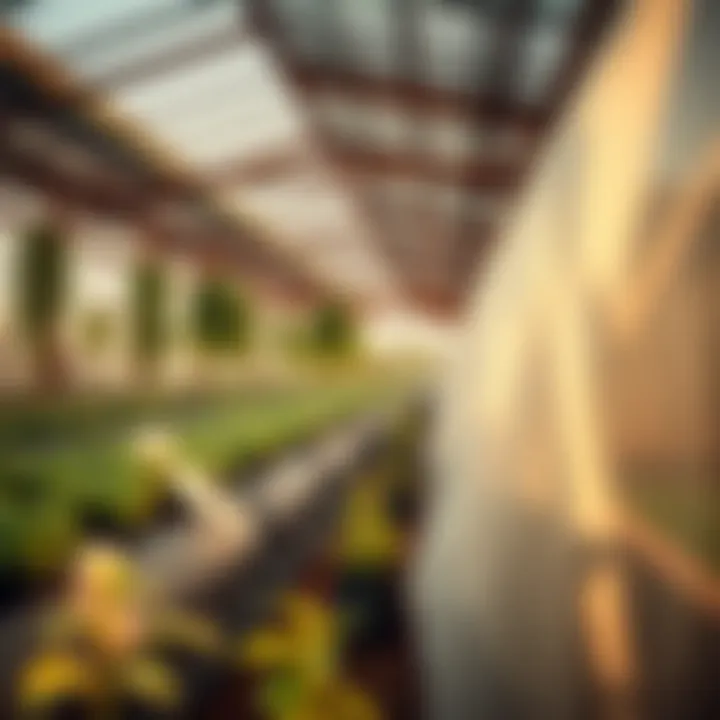
Dubai has long been recognized for its towering skyscrapers and luxurious lifestyle. However, the role of greenery has slowly become crucial in reshaping urban life here. The assortment of green spaces contributes greatly to the aesthetic appeal of the city. They provide not just a visual delight but act as sanctuaries offering respite from the urban hustle. This section aims to delve into various types of green spaces found in Dubai, examining their distinct advantages and considerations.
Parks and Public Gardens
Parks and public gardens serve as the lungs of Dubai. The sheer diversity of parks contributes to the city's identity, offering a blend of recreation, relaxation, and rejuvenation. For instance, the Dubai Creek Park is not just a beautiful area with towering palm trees and vibrant flowerbeds; it also features an array of family-friendly amenities like playgrounds and picnic spots.
Another notable example is the Safa Park, where individuals can unwind while indulging in lush greenery. The design of parks allows for social interaction among community members, promoting a sense of belonging. This visibility of greenery breaks the monochrome palette commonly associated with urban environments, leading to improved mental well-being among residents and visitors alike.
Furthermore, the expansion of parks often leads to increased property values in adjacent areas, making them attractive not just for residents but also potential investors. It’s clear that parks are more than just a pretty sight; they hold meaningful impact on both community spirit and economics.
Vertical Gardens and Green Roofs
With land space at a premium in this desert city, innovative solutions have emerged. Vertical gardens and green roofs have found their niche among the high-rises. These living walls, often festooned with plants like Ivy or Bamboo, capitalize on vertical surfaces to enhance air quality and decrease urban heat levels.
Take the Burj Khalifa, for instance. While its stature is imposing, the incorporation of green terraces offers not only aesthetic appeal but demonstrates a commitment to sustainability. This doesn’t just beautify the skyline, it fosters a healthier atmosphere.
Moreover, these installations can mitigate the urban heat island effect, making a significant difference in the urban climate. The integration of nature into urban architecture speaks volumes about Dubai’s vision for a greener future.
Community Gardens
Community gardens have emerged as a grassroots response to urban living challenges. They cultivate not only fruits and vegetables but also strengthen community ties. In neighborhoods like Al Quoz, these gardens serve as fruitful havens where residents can contribute, cultivate, and harvest together.
These gardens encourage sustainability and self-sufficiency, allowing individuals to engage in urban farming. This practice also helps educate people about food origins, fostering a culture of healthy living. Additionally, community gardens often become focal points for social gatherings, enhancing local networks. The simple act of gardening can be a transformative experience, allowing people from varied backgrounds to connect over their shared goals.
In summary, the variety of green spaces in Dubai—from sprawling parks to innovative vertical gardens and vibrant community farms—reflects a growing awareness of the need for green integration in urban life. They not only provide vital ecological benefits but enrich social fabric and property dynamics, making them indispensable in Dubai's urban landscape.
Government Initiatives
The influence of government initiatives in fostering greenery in Dubai is pivotal not only for the environment but also for the urban population’s quality of life. The leadership’s commitment towards creating sustainable urban areas shows a forward-looking perspective that takes into account not just present needs, but future ones too. Greenery projects are emblematic of Dubai's ambition to blend modernity with sustainability.
Government initiatives related to greenery are instrumental in enhancing the urban landscape, supporting biodiversity, and promoting community engagement.
Sustainability Goals and Policies
Dubai’s ambitious sustainability goals are woven into a tapestry of policies aimed at integrating green practices into every facet of urban life. The Dubai Clean Energy Strategy 2050 stands out; it signifies a commitment to generating 75% of the city’s energy from clean sources by the designated year. Within this framework, various green policies have been enacted, aiming not just at afforestation but also at incorporating sustainable practices within the real estate sector. The Vision 2021 further illustrates this commitment by emphasizing the importance of green areas, public parks, and tree planting as a means of improving the urban environment.
This focus on sustainability translates into a myriad of benefits:
- Enhanced Air Quality: More green areas lead to better air circulation and pollutant filtration, improving the health of citizens.
- Urban Heat Reduction: Trees and plants provide shade and cooling, mitigating the ‘urban heat island’ effect that cities like Dubai can experience.
- Biodiversity Support: Planting native species contributes to local ecosystem health, enhancing the habitat for urban wildlife.
Efforts such as the Dubai Urban Master Plan align closely with these goals, demonstrating a clear path to integrating greenery in both existing and future urban infrastructural projects. These policies serve as a cornerstone for long-term green planning, significantly benefiting community well-being.
Green Building Regulations
Green building regulations in Dubai are another crucial aspect of boosting greenery in the urban sphere. The Dubai Municipality, as part of its building code, promotes the concept of sustainable construction practices. These regulations require developers to incorporate green materials, energy-efficient designs, and sustainable landscaping practices into their projects. Such mandates not only contribute aesthetically but also lessen the resource demand on the environment.
Benefits of these regulations include:
- Improved Energy Efficiency: A focus on energy-efficient structures means reduced energy consumption, which is cost-effective in the long run.
- Water Conservation: Encouraging the use of smart irrigation systems and drought-resistant landscaping helps in conserving one of the region's most precious resources—water.
- Waste Reduction: Regulations encourage recycling and responsible waste management during construction, supporting a more circular economy.
Through these initiatives, Dubai illustrates how regulations can serve to marry economic growth with environmental stewardship. This dual focus is increasingly attractive to investors looking for sustainable opportunities in a rapidly evolving city.
Impact of Greenery on Quality of Life
The significance of greenery in urban settings, particularly in a city like Dubai, cannot be overstated. As this bustling metropolis continues to expand, the integration of green spaces plays a central role in shaping the quality of life for its residents. In an environment where concrete dominates, the presence of greenery offers not only aesthetic beauty but also tangible benefits for mental, social, and physical well-being. Here we will break down the positive impacts of greenery on life in Dubai, addressing how these spaces contribute to a healthier and more vibrant community.
Mental Health and Well-being
Studies consistently show that access to green spaces translates to improved mental health outcomes. In Dubai, with its fast-paced lifestyle and cultural diversity, the pressures can be overwhelming. The simple act of spending time in a park filled with trees and flowers can lower stress levels, reduce feelings of anxiety, and promote overall mental well-being.

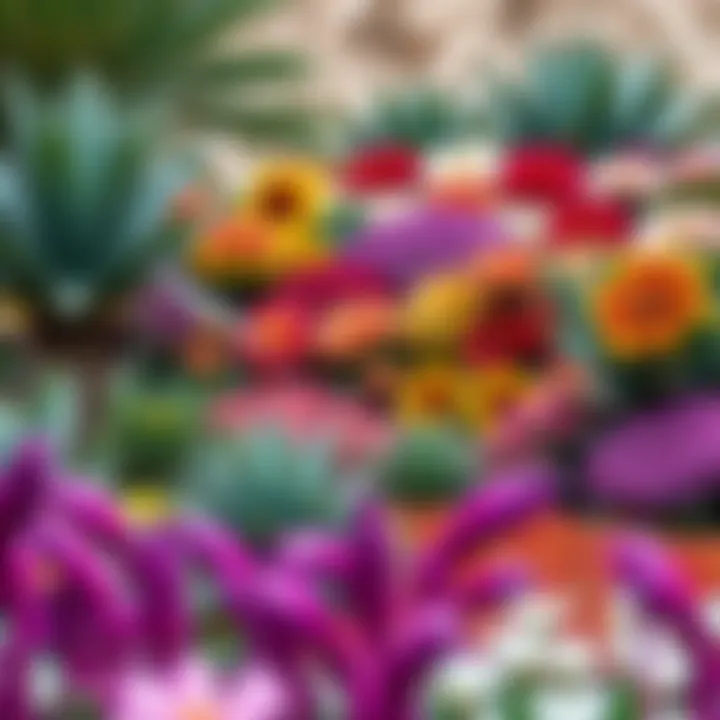
For instance, a stroll through Al Barsha Pond Park or a leisurely afternoon in Safa Park can be a reprieve from the hustle and bustle of city life. Being surrounded by nature encourages relaxation and boosts mood. It can be likened to a breath of fresh air amidst the noise and chaos—a calming presence.
Here are some key mental health benefits associated with greenery:
- Reduction of Stress: Engaging with natural environments can lower cortisol levels, the body's stress hormone.
- Enhanced Mood: Exposure to greenery has been linked with positive mood changes and can combat depression.
- Improved Focus: Nature can restore attention and reduce mental fatigue, which is particularly beneficial for those balancing work and personal life.
Social Interactions and Community Building
Green spaces serve as communal hubs, providing a platform for social interactions that go beyond casual encounters. In a culturally rich city like Dubai, parks and gardens foster connections among individuals from varying backgrounds. They create informal venues for community gatherings, allowing residents to come together for activities, celebrations, or even casual meet-ups.
Take the Dubai Marina Walk, for example—this picturesque promenade encourages locals and tourists alike to mingle while enjoying the views. Sitting on a bench by the water can lead to conversations that might not have happened if everyone were confined to their homes or shopping centers.
A few notable social benefits include:
- Promoting Inclusivity: Green spaces are open to all, providing a neutral ground where people from diverse backgrounds can engage.
- Encouraging Active Lifestyles: Having accessible greens encourages people to partake in outdoor activities, from jogging to yoga classes, which can strengthen local bonds.
- Fostering Community Cohesion: Regular events at parks or gardens, like workshops, farmers' markets, or picnics, create a sense of belonging among residents.
"Green spaces in an urban context are not just about vegetation; they're about people. They connect us, foster friendships, and build communities."
As we see, the role of green spaces extends far beyond aesthetics. They are crucial to improving mental well-being and enriching social interactions, thus enhancing the overall quality of life in Dubai. While the challenges of urban density can be significant, the continued emphasis on integrating greenery into the cityscape shows a commitment to the well-being of its residents.
For further extensive research, these resources can provide valuable insights: www.britannica.com, www.reddit.com/r/dubai.
The Role of Greenery in Real Estate Development
Incorporating greenery into real estate development environments in Dubai has shifted from being a niche idea to a cornerstone of urban strategy. Green spaces, ranging from carefully landscaped parks to vertical gardens, can influence purchasing decisions and property valuation. As communities strive for a blend of nature within urban settings, understanding the interaction between greenery and real estate offers insightful advantages for investors and developers alike.
Increased Property Values
Having greenery nearby can lead to tangible increases in property values. Studies indicate that properties situated within close proximity to parks and gardens can command higher prices. Buyers appreciate access to naturally pleasant outdoor spaces for relaxation and recreation.
- Aesthetic Appeal: Well-maintained greenery enhances the visual attractiveness of a property, making it more desirable.
- Perceived Value: Properties near established green spaces often enjoy heightened perceived value, attracting buyers willing to pay a premium.
- Market Trends: The trend is clear: areas with abundant greenery show a steady appreciation in property values.
- Lifestyle Choices: An environment that promotes a healthy lifestyle through active outdoor spaces attracts affluent buyers who prioritize well-being.
The numbers speak volumes. Properties close to green areas, like Al Barsha Park or Safa Park, often show a marked increase in value over time compared to those that are not as fortunate. This trend underscores the concept that greener is better, translating directly into financial gain for investors.
Attracting Investors and Buyers
Greenery is not just about aesthetics; it plays a vital role in attracting investors and buyers. Developers keen on maximizing their returns are increasingly integrating biophilic designs which appeal to the modern buyer.
- Investor Interest: As the focus on sustainability grows, investors are more inclined to seek developments that showcase innovative green solutions. Sustainable properties often have lower operating costs, offering financial returns in the long run.
- Project Differentiation: Properties that incorporate green technology, like smart irrigation systems, can stand out in a crowded market. Buyers may favor these developments for their eco-friendly credentials.
- Community Cohesion: Well-designed green spaces foster community interactions, making projects more attractive to potential buyers and enhancing the value of a property by promoting a sense of belonging.
- Resale Potential: Whether it’s the lush gardens in Dubai Marina or beautiful greenery in Jumeirah, homes that feature green spaces often boast better resale potential, drawing interest from future buyers.
By recognizing the role of greenery in real estate, stakeholders can adapt to current trends, ensuring they not only meet but exceed market expectations.
Greenery isn't just a trend; it's a fundamental shift in how we perceive and develop urban spaces.
Challenges to Urban Greening
Urban greening in Dubai is an admirable pursuit that brings numerous benefits, but it is not without its hurdles. Understanding these challenges is crucial for anyone involved. As the city strives to blend lush environments within its sprawling desert landscape, addressing obstacles that arise is vital. These challenges predominantly revolve around climate adaptations and spatial constraints in urban areas.
Climate Adaptations
In a region characterized by extreme temperatures and arid conditions, integrating greenery into urban planning requires careful consideration of climate adaptability. With temperatures soaring above 40 degrees Celsius during the summer months, selecting the right plant species becomes paramount.
Drought-resistant plants like succulents and native species are increasingly favored. They’re better equipped to survive harsh summers while also minimizing water use. Moreover, efficient irrigation systems, such as drip irrigation, help to ensure that these plants receive the necessary moisture without wastage. The local government has even implemented smart irrigation systems that adapt to current weather conditions, ensuring optimal water usage.
"Using technology to monitor soil moisture not only conserves water but also promotes a healthier urban ecosystem."
This kind of strategic planning can transform urban landscapes, but it requires ongoing investment and research. Local universities and environmental organizations are collaborating to develop innovative solutions that will ensure greenery continues to thrive amidst climate fluctuations.
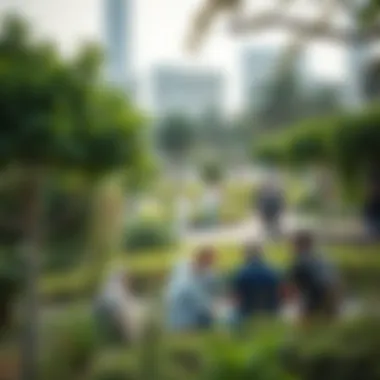

Space Limitations in Urban Areas
Dubai, with its rapidly expanding skyline, faces significant limitations related to available green space. Urban sprawl makes it a challenge to find sufficient land that can be dedicated to parks, gardens, and other green initiatives. As construction booms, the push for more buildings often overshadows greenery needs.
Vertical gardens and green roofs provide creative alternatives to conventional landscaping. By utilizing wall space and rooftops, urban developers can introduce vegetation without needing extra land. This not only beautifies the city but also helps in insulating buildings, thus reducing energy consumption.
However, to fully realize this potential, developers, city planners, and investors have to collaborate closely. There is often a tussle between maximizing property value and setting aside space for greenery. It’s necessary to foster a culture where both can coexist.
As urban planners and developers, the goal is to overcome these challenges meticulously, creating a vision where greenery is a fundamental element of urban living. It requires innovative thinking, a commitment to sustainability, and a willingness to adapt.
Innovative Green Technologies
Green technologies are rapidly changing how we approach urban greening, especially in a city like Dubai where the desert backdrop creates unique challenges. The adoption of innovative green technologies signifies a blend of environmental sustainability and urban development. They cater to the pressing need for effective resource management while enhancing the city's aesthetics and livability. These technologies not only address practical issues but also elevate the quality of life for residents, contributing to a more eco-friendly urban environment.
Smart Irrigation Systems
One of the cornerstones of greenery initiatives in Dubai is the smart irrigation systems. These systems utilize advanced technologies to create optimally managed watering solutions. By automating irrigation practices through sensors and data analytics, Dubai can significantly reduce water consumption while ensuring that plants receive the precise amount of hydration they need.
Benefits of Smart Irrigation
- Water Conservation: Traditional irrigation methods often lead to water wastage. Smart systems adapt to weather conditions, soil moisture, and plant requirements, substantially lowering water use.
- Cost Efficiency: With the reduction in water consumption, it translates to cost savings in water bills for both residential and commercial properties.
- Healthier Plants: Regular and targeted watering promotes better plant health, encouraging lush greenery across the city.
The integration of smart irrigation is not just a technical upgrade. It leads to a shift in mindset regarding water use in the arid climate of Dubai, making sustainable practices more commonplace.
Hydroponics and Vertical Farming
Hydroponics and vertical farming represent a leap forward in sustainable agriculture within urban settings. In a city where space is at a premium, these methods allow for efficient food production without sprawling land use. Hydroponics, which involves growing plants in nutrient-rich water, and vertical farming, which stacks crops in controlled environments, are innovative responses to food security issues in a desert landscape.
Advantages of Hydroponics and Vertical Farming
- Space Efficiency: Vertical systems can produce food in areas where ground space is limited, effectively transforming underutilized sites into green production zones.
- Reduced Climates Impacts: Growing indoors minimizes the impact of harsh weather conditions. It ensures year-round production while shielding crops from pests and diseases.
- Nutrient-Rich Growth: Hydroponic methods often produce crops with higher nutrient values, benefiting local communities nutritionally.
In essence, the futurity of greenery in Dubai hinges on the implementation of innovative green technologies. These methods not only promise to adapt the urban landscape but also showcase a commitment to sustainability, thereby encouraging investment in green real estate initiatives.
"Sustaining green spaces in a city like Dubai is no small feat, but the innovation in technology makes it not only possible but progressive."
The potential of these technologies open doors for investment opportunities, allowing investors and buyers alike to envision a greener Dubai where natural beauty meets urban development. Resources such as USDA.gov provide insights and guidelines for implementing such technology, ensuring adherence to sustainability practices.
As Dubai continues to evolve, the marriage of technology and nature presents an intriguing future, promising not just aesthetic enhancement but significant societal benefits.
Future of Green Spaces in Dubai
The future of green spaces in Dubai stands as a beacon of potential amid an ever-urbanizing landscape. As this vibrant city undergoes reforms and innovations in the pursuit of sustainability, the importance of greenery has never been more apparent. The integration of parks, gardens, and other green infrastructure is not merely an aesthetic upgrade; it is a critical component for enhancing urban life and fostering community well-being. This article delves into various aspects of what the future holds for greenery in Dubai while highlighting specific benefits and considerations.
Vision for a Greener City
Dubai's vision for a greener city reflects a paradigm shift in how urban environments are conceived and designed. Recognizing that natural landscapes can coexist with industrial advancement, the municipality aims to create a harmonious synergy between nature and urban living. Major initiatives focus on increasing the share of green spaces in residential and commercial areas.
Examples of this vision include:
- Expanded Park Networks: The introduction of new parks in strategic locations promotes accessibility for all residents.
- Community Engagement Programs: Residents are encouraged to participate in the planning and upkeep of public gardens, giving them a sense of ownership and responsibility towards their local environment.
- Sustainable Landscape Practices: Implementing eco-friendly landscaping that prioritizes drought-resistant plants not only reduces water consumption but establishes a diverse ecosystem even in the desert.
“In creating a greener Dubai, we are investing in the long-term health and happiness of our community,” state urban planners, emphasizing that this is as much about enhancing quality of life as it is about beautification.
This ambitious vision shapes the future of urban planning in Dubai, one that isn’t merely about constructing tall buildings and luxury resorts, but about building a city where flora and fauna also thrive alongside human activity.
Potential for Expansion and Development
The potential for expansion and development of green spaces in Dubai looks promising and multifaceted. Key areas are already being identified and targeted for green enhancement—making those who invest in these developments highly motivated prospects. Some important considerations include:
- Integration into Real Estate Projects: Developers are increasingly incorporating green areas into their projects. This is not merely an afterthought, but part of the overall appeal meant to elevate property value and attract buyers.
- Regenerative Urban Planning: As older neighborhoods undergo redevelopment, there is an opportunity to incorporate a larger footprint for greenery, including more parks and communal spaces that invite social interactions.
- Technological Innovations: Use of smart layouts and technologies can transform how greenery interacts with residential units. For example, biophilic design principles are becoming popular, where workflows prioritize natural light and ventilation, integrating indoor plants and outdoor views directly into living areas.
With sustainability trends guiding investments and practices, the city is poised for a revolution in its approach to urban greening. As new developments arise with green partnerships in mind, they are likely to form benchmarks that can stream down into smaller, private projects by aspiring developers.
For further insights on the topic of sustainable urban planning and landscapes, visit Britannica or review governmental resources on sustainability goals available at Dubai Government Services.











